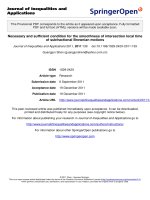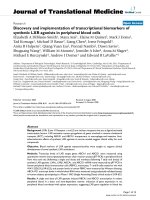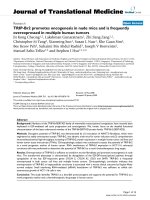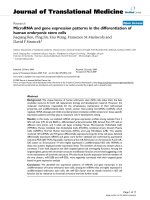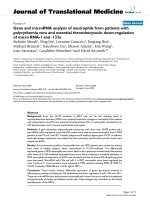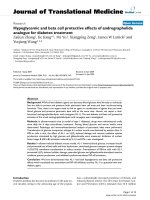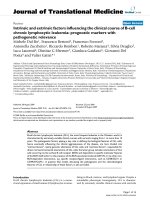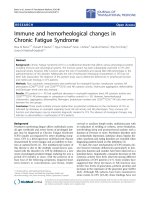Báo cáo hóa học: " Mobility and livestock mortality in communally used pastoral areas: the impact of the 2005-2006 drought on livestock mortality in Maasailand" pptx
Bạn đang xem bản rút gọn của tài liệu. Xem và tải ngay bản đầy đủ của tài liệu tại đây (315.1 KB, 17 trang )
RESEARCH Open Access
Mobility and livestock mortality in communally
used pastoral areas: the impact of the 2005-2006
drought on livestock mortality in Maasailand
David Nkedianye
1,2*
, Jan de Leeuw
1
, Joseph O Ogutu
1,3
, Mohammed Y Said
1
, Terra L Saidimu
4
, Shem C Kifugo
1
,
Dickson S Kaelo
1
and Robin S Reid
5
* Correspondence: nkedav@yahoo.
com
1
International Livestock Research
Institute, P.O. Box 30709 00100,
Nairobi, Kenya
Full list of author information is
available at the end of the article
Abstract
There is consensus that pastoral mobility is beneficial for both pastoralists and the
environment. However, rapid change arising from multiple factors, including
landscape fragmentation, sedentarization, and demographic drivers might affect the
effectiveness of this pastoral coping strategy in times of drought. We investigate
livestock mortality rates following the 2005 drought in four areas in Maasailand: the
Maasai Mara, the Kitengela plains, the Amboseli, and the Simanjiro plains . The main
aim was to assess the mortality of resident livestock in relation to incoming livestock
during the drought. Contrary to our expectations, livestock mortality rates were
significantly higher (43%) in Kitengela, which experienc ed above-average rainfall,
compared to the other three areas which had below-average rainfall yet experienced
mortality rates between 14% and 30%. Two processes might explain this surprisingly
high mortality rate. Firstly, the immigration of large numbers of livestock from
drought-stricken areas into the highly fragmented Kitengela area increased stocking
density, which worsened the shortage of forage and water. Secondly, the more
market-oriented but less drought-resistant livestock breeds in Kitengela form another
explanation for the increased mortality. These observations suggest that pastoral
mobility may lead to greater sensitivity to drought especially in fragmented areas
where more market-oriented but less drought-resistant livestock breeds are
introduced. We argue that in such areas, there is a crucial need to adopt practices
that simultaneously minimize land fragmentation and enhance pastoral mobility and
access to information on improved livestock breeds and markets.
Keywords: drought, East Africa, mobility, livestock mortality, improved breeds,
fragmentation
Background
Pastoral livestock production, the dominant land use in the arid and semi-arid lands of
Africa, provides a livelihood to millions of people. Traditionally, pastoral societies have
been relatively wealthy and even today the livelihoods of pastoralists tend t o compare
well with others in years of good rainfall. The arid lands of Africa experience fre-
quently recurring droughts; however, these have significant effects on livestock and
pastoral livelihoods alike (Zamani et al. 2006; Le Houerou 1996; Oba and Lusigi 1987).
Nkedianye et al. Pastoralism: Research, Policy and Practice 2011, 1:17
/>© 2011 Nkedianye et al; licensee Springer . This is an Open Access article distributed under the terms of the Creative Commons
Attribution License (http://creativecom mons.org/licenses/by/2.0), which permits unrestricted use, distribu tion, and reproduction in
any medium, provided the original work is properly cited.
Pastoral societies were considered resilient to drought as they traditionally recovered
during years of better rainfall. Recently, this perception of pastoral resilience is under
increasing scrutiny as social, economic, and environmental factors exert more pressure
in these systems. In some areas, such as the horn of Africa, sequences of recurring
droughts push pastoralists out of livestock and into poverty and food aid dependency
(Fratkin 2001; Campbell 1999; Spencer 1974).
What caused this weakening of pastoral resilience? Traditionally, a number of strate-
gies were used to prevent or alleviate the effects of drought. Firstly, pastoralists main-
tained large herds to ensure that suffi cient anim als would survive to rebuild the herds
after the drought (McPeak 2005). In many areas, the resilience provided by large herds
has been greatly eroded becau se, due to demographic growth , per capita herd size has
reduced (Lamprey and Reid 2004; Sindiga 1984), hence increasing vulnerability t o
drought. The loss of pastoral lands, which were used as droug ht refuges to agriculture,
conservation (Homewood et al. 2009; Brockington 2005; McCabe 2003) and urbaniza-
tion (Behnke 2008), and sedentarization from a formerly semi-nomadic lifestyle and
the associated land fragmentation and intensification of land use further reduced resili-
ence. Secondly, pastoralists reduce risk while spreading their animals over herds of
relatives and maintain social institutions to support those affected by drought. These
strategies are , however, under increasing pressure due to weake ning of the social net-
works which once supported them.
Pastoral mobility is probably the oldest described drought coping strategy, as in Gen-
esis 47:3-4 (The Bible 2009) where the Israelites explain their migration into Egypt
before the Pharaoh as follow s: “We have come to live here awhile, because the famine
is severe in Canaan and your servants’ floc ks have no pastur e. So now, please let your
servants settle in Goshen.” During the colonial period in East Africa at the beginning
of the twentieth century, the idea that mobility has benefits gained support when the
colonial administration in Kenya and Tanzania tried to disrupt pastoral mobility
(Borjeson et al. 2008; Hughes 2006; Hodgson 2001; Rutten 1992).
Today, there is consensus regarding the social benefits of pastoral mobility, and the
“blessings of pastoral mobility hypothesis” has thus attained the status of a paradigm.
Although it is doubtless that mobility has been and will continue being helpful to pas-
toralists, the paradigm is mainly built, on a mixture of deductive argument and positive
experiences from the past.
One problem of the blessings of pastoral mobility paradigm is that it does not high-
light the costs of mobility, especially to resident communities. It is obvious that herds-
men, when confronted with drought, may b enefit while moving their livestock to
greener areas to reduce the mortality of their herd. The paradigm does not consider
the negative social impacts for those inhabiting t he lands rec eiving the hungry herds.
That was probably also irrelevant in biblical times, as there was sufficient space. Simi-
larly, following the rinderpest epidemic and depopulation in the 1890s (Rutten 1992;
Talbot 1972) there must have been ample space in the rangelands in the Maasailand of
the early twentieth century. Hence, competition with resident herds was unlikely at
that time.
The situation is different today. In Maasailand, there is no more “no man’s land” and
little if any underutilized land. Today, pastoral mobility as a strategy to escape drought,
means moving into lands utilized by others and often to far-flung areas. Such
Nkedianye et al. Pastoralism: Research, Policy and Practice 2011, 1:17
/>Page 2 of 17
protracted movements and immigration into commonly used lands increases competi-
tion for forage and water resources (Hardin 1968) and the risk of contracting diseases,
a situation that will affect the body condition of resident and immigrant livestock alike.
Thus far, there has been no study addressing the benefits of pastoral mobility under
conditions of intensifying utilization of rangeland resources.
In this study, we investigated mortality rates recorded during the 2005-2006 drought
among 396 households in four areas of East African Maasailand. Three out of the four
areas experienced below-average rainfall while the fourth had above-average rainfall.
Pastoral mobility resulted in a significant influx of livestock in the latter site, but not
in the first three sites. This contrast between the four sites enabled us to compare
mortality rates among drought-affected and non- drought-a ffected sites, in the expecta-
tion that the non-drought-affected site would reveal lower mortality rates.
Materials and methods
Study area
The research was undertaken in four sites across Maasailand (Figure 1), three in Kenya
(Mara, Kitengela, and Amboseli) and one in Tanzania (Simanjiro). Table 1 describes
#
#
#
#
#
Nairobi
Moshi
Arusha
Sultan Hamud
Mashuru
0 100 200 Kilometer s
N
1
3
2
4
Kenya
Tanzania
Location Map
Figure 1 Map of the study areas showing the four study sites. 1, Ambo seli; 2, Kitengela; 3, Mara; and
4, Simanjiro). Arrows indicate migration of livestock towards the Kitengela area, broken line indicates
International boundary.
Nkedianye et al. Pastoralism: Research, Policy and Practice 2011, 1:17
/>Page 3 of 17
Table 1 Characterization of the four study sites
Site Rainfall
(mm)
Land tenure Land use Land cover (%)
Amboseli (8,400 km
2
) 350-600
(Bimodal)
Group ranches. Private Livestock, wildlife, agriculture and horticulture G, 34; S, 5; WB, 60; W, 1
Kitengela (390 km
2
) 440-900
(Bimodal)
Privately owned, subdivided from 1986 Livestock, wildlife, agriculture and horticulture G, 91; S, 7; WB, 1; urban areas, 1
Maasai Mara (6,500 km
2
) 400-1200
(Bimodal)
Privately owned, subdivided from 2000 Livestock, wildlife, little agriculture Grassland, 60; S, 34; WB, 6
Simanjiro 384.2 650-900
(Bimodal)
Government owned, village control Livestock, wildlife, expanding agriculture G, 62; WB, 28; C, 10
Characterization in terms of climate, land tenure, land use, and main vegetation types within the specific study areas. C, cropland; G, grassland; S, shrubland; U, urban areas; WB, woodland and bushland; W, water.
Nkedianye et al. Pastoralism: Research, Policy and Practice 2011, 1:17
/>Page 4 of 17
the climate, vegetation and land tenure, and use of the four sites. Rainfall is bimodal
with the long rains (Kenya Meteorological Department 2008) being heavier and more
reliable in Kiteng ela, Simanjiro, and the Maasai Mara (Ogutu et al. 2007; Njo ka 1979;
Pratt et al. 1966) and the short rains in October-December being more pronounced in
Ambosel i (De Leeuw 1991). The El Niño-Southern Oscillation causes quasi-cyclicity in
rainfall in Maasa iland (Ogutu e t al. 2007; Mworia and Kinyama rio 2008) and is most
pronounced during the October-December season (Ogallo et al. 1988).
There is regional variation in the distribution of breeds of cattle, sheep, and goats,
which reflects choices made by pastoralists in response to prevailing market demands,
climatic, and disease-related constraints. Traditional breeds prevail in most areas due
to constraints such as Trypanosomosis in the Mara an d parts of Simanjiro and the dry
and hot conditions in the Amboseli. More market-oriented breeds such as Dorper
Sheep and Boran/Sahiwal and their crossbreeds have been introduced in the Kitengela
plains (Table 2).
Livestock mortality survey
Livestock mortality surveys were conducted by locally recruited enumerators in one
hundred randomly selected households per study site during the 3 months (May to
July 2006) i mmediately after the drought of March-April 2006. The se multi-si te simul-
taneous surveys are rarely done but were possible to conduct because the senior author
of the paper and the enumerators were all native Maa-language speakers. The enu-
merators, who all had an “ordinary level” certificate in formal education and prior sur-
veying experience, were thoroughly trained before the survey. Livestock losses were
recorded by livestock species by household and per site. Livestock numbers were con-
verted into Tropical Livestock Units (TLU) by multiplying total numbers of cattle by
0.72 kg, while sheep and goats (shoats) numbers were multiplied by 0.17 kg (Radeny et
al.2007).Aglobalpositioningsystem(GPS) was used to fix the location of the
homesteads.
Statistical analysis
Annual rainfall data from multiple weathe r stations in each of the four areas (seven in
Kitengela, nine in the Mara, eight in Amboseli, and five in Simanjiro) were obtained
from the meteorological departments of Kenya and Tanzania, and averaged to one
annual rainfall value for each study area to filter out spatial variation. We analyzed the
temporal variation in annual rainfall using standardized anomalies (
z =(x
t
−
¯
x)/σ
),
where x
t
is the rainfall component in ye ar t,
¯
x
is the mean, and s is the standard
deviation of the rainfall component during 1960-2007 (Ogutu et al. 2007) (Figure 2).
We analyzed the variation in the proportion of livestock that died across the four
sites during t he drought of 2005-2006, and compared the results across the four sites
to establish the ef fects of drought on livestock mortality. The analysis was performed
at an aggregated livestock (c attle, sheep, and goats) level expressed in TLU, as well as
for the three species separately.
We used a generalized linear model with mortality rate as the dependent and site as
the independen t categorical variable, to analyze differences in livestock mortality rates
among the four sites. Averaging of mortality over the households would lead to a
Nkedianye et al. Pastoralism: Research, Policy and Practice 2011, 1:17
/>Page 5 of 17
Table 2 Description of the main livestock breeds in the four study areas
Site Cattle Sheep Goats
Amboseli Maasai Zebu Blackhead Somali, Red Maasai Mixed: Galla, Small E. African
Kitengela Boran, Sahiwal crosses, Maasai Zebu Dorper, mixed Dorper × Red Maasai Mixed: Galla, Small E.African
Mara Maasai Zebu Red Maasai Mixed: Small E. African, Maasai
Simanjiro Maasai Zebu Red Maasai, Blackhead Somali Mixed: Small E. African, Maasai
Nkedianye et al. Pastoralism: Research, Policy and Practice 2011, 1:17
/>Page 6 of 17
biased estimate of the overall mortality, because there were significant differences in
herd size between households. We therefore weighted the cases as follows:
W
i,j
=
x
i,j
¯
x
i
Figure 2 Standardized anomalies from the long-term mean ( 1961-2007) of annual rainfall for the
four study sites. With an interpolation based on the 3-year running mean revealing quasi-cyclicity in the
rainfall data. Dashed horizontal lines are 2 standard deviations (1.96) from the average (0). The vertical
dashed lines identify the year 2003 as a reference year, while arrows point at the year 2005.
Nkedianye et al. Pastoralism: Research, Policy and Practice 2011, 1:17
/>Page 7 of 17
Where w
i, j
and x
i, j
represent the weight and herd size (in TLU) for the jth house-
hold at the ith site, respectively, and
¯
x
i
the average herd size at the ith site.
Financial loss caused by drought
We also estimated the monetary value of the loss of livestock per household. For this,
we multiplied for each of the four areas the average numbers of cattle, sheep, and
goats lost per household by the monetary value of each of these three species based on
prevailing prices at the local sale points for the period before the onset of the drought.
An average price of Ksh 18,000 and Ksh 15,000 was used for cattle in Kitengela and
the other areas, respectively, while an average price o f Ksh 2,000 and Ksh 1,500 was
used for sheep and goats in Kitengela and the other areas, respectively (Table 3).
Narrative
The analysis revealed surpri sing mortality rates in Kitengela. To explain this, we com-
piled a narrative of what happened in Kitengela during the drought and in the preced-
ing year (Table 4). The narrative describes the movements a nd the conditions of the
immigra nt and resident livestock as well as the condition of th e rangelands. It is based
on the recollection of the lead author, who lived and owned livestock in Kitengela dur-
ing this period. The narrative was cross-checked with concurrent experiences of a peer
group of livestock owners and traders of different ages who lived in the wider Kiten-
gela area. Where appropriate, reference is made to their experiences.
Results
Figure 2 describes the variation in standardized annual rainfall for the 47-year period
during 1961-2007. The figure reveals that Kitengela received above-average rainfall in
2005, while rainfall in Amboseli, Simanjiro, and the Mara was below average. Hence
Table 3 Livestock mortality in percentage, and the estimated loss in monetary value by
livestock species
Site Class Total died % died CostKsh-000
a
Average Ksh per household US$ per household
Amboseli Cattle 2,158 32 32,370 323,700 4,465
Sheep 1,665 27 2,498 24,975 345
Goats 891 24 1,337 13,365 134
Total 36,204 362,040 4,994
Kitengela Cattle 2,149 45 38,682 386,820 5,335
Sheep 4,586 47 9,172 91,720 1265
Goats 1,095 35 2,190 21,900 302
Total 50,044 500,440 6,903
Mara Cattle 2,793 29 41,895 418,950 5,779
Sheep 2,836 21 4,254 42,540 587
Goats 559 22 839 8,385 118
Total 46,988 469,875 6,481
Simanjiro Cattle 1,091 13 16,365 163,650 2,257
Sheep 451 11 677 6,765 93
Goats 895 23 1,343 13,425 185
Total 18,384 183,840 2,536
Livestock mortality (in absolute numbers) and as percent of initial numbers, the estimated loss in monetary value by
livestock species per site-(for 100 households sampled).
a
Absolute numbers for shoats multiplied by 2,000 for Kitengela
and 18,000 for cattle. For all other sites, the total died is multiplied by 1,500 for shoats and 15,000 for cattle. The
differences in prices among sites are based on general differences in weights for different livestock breeds.
Nkedianye et al. Pastoralism: Research, Policy and Practice 2011, 1:17
/>Page 8 of 17
from a meteorological perspective, three areas experienced a drought, while Kitengela
didnot.Thefigure,furthermore,revealsthat Amboseli, Simanjiro, and the Mara also
experienced drought in 2004, while Kitengela had close to normal rainfall.
There was a significant difference in mortality rates between the four sites (weighted
ANOVA; F
3,390
= 40.91; P < 0.001). A pair-wise multiple comparison adjusted for mul-
tiplicity using the Bonferoni correction revealed that all sites differed from each other
(All Ps < 0.001). However, the difference between Amboseli and the Mara was insignif-
icant (P = 0. 751). Surprisingly, Kitengela incurred the highest overall livestock mortal-
ity rate of 43%. The Amboseli, Mara, and Simanjiro had mortality rates of 30%, 26%,
and 14%, respectively.
The level of mobility differed across the four sites depending on the available flexibil-
ity in space. In the three less fragmented sites m ost of t he movement was within t he
general area. In the Kitengela site, most of the influx of livestock was from adjoining
areas. Where mobility is limited, one would expect mortality rates to increase with the
severity of drought. Figure 3 confirms such a pattern for the three sites affected by the
drought. However, Kitengela forms an outlier because it has a much higher mortality
than would be expected by the severity of drought alone, considering that the area
experienced no drought. It is worth reiterating here that Kitengela had more extreme
land fragmentation and more drought-sensitive livestock breeds.
During the interviews with herdsmen, we noted large numbers of immigrant live-
stock in the Kitengela plains in 2004-2005. These herds arrived from mid-2004
onwards, following failure of the long and short rains in Mashuuru and Sultan Hamud
to the south-east of Kitengela (Table 4 and Figure 1). Most of the immigrant herds dis-
appeared in the middle of 2005 after they had depleted the forage produced during the
above-average long rains earlier that year. In the other three areas, there was internal
migration, but no immigration of livestock.
Thus far, we considered herd mortality rates, which are the result of the combined
mortality of sheep, goats, and cattle. The herd composition differed somewhat between
the three areas (Figur e 4) and the differences in mortality rates coul d thus reflect dif-
ferences in herd composition. In all the sit es, cattle contributed most to the overall
Table 4 Narrative of the condition of the rangelands and the movements of resident
and immigrant herds
Period Event(s)
2004 March-May Average long rains
2004 June First immigrant herds arriving from drought-stricken areas of Sultan Hamud and Mashuru
in the South-east
2004 October-
December
Good short rains
2005 March-May Above-average long rains, good productivity of rangelands
2005 May-June More immigrant livestock arriving, stocking density at least twice the normal
2005 August All grass depleted
2005 October-
November
Failure of short rains, severe competition between resident and immigrant herds
2005 December Start of mortality, first among immigrant followed by resident herds
2006 February-
March
Peak mortality for all livestock
2006 March-April Onset of the rains, continued mortality of weakened livestock due to pneumonia and
other diseases
In the Kitengela area before and during the 2005-2006 drought.
Nkedianye et al. Pastoralism: Research, Policy and Practice 2011, 1:17
/>Page 9 of 17
herd biomass (in TLU). There were some differences, with Amboseli, the Mara, and
Simanjiro areas having 78%, 78%, and 77% of herd biomass, respectively, composed of
cattle. In Kite ngela, cattle contributed somewhat less (62%) to overall herd biomass,
reflecting a relatively higher proportion of small stock. Table 3 reveals that most of the
variation in herd mortality between the four areas was attributable to differences in
mortality rates of the three livestock species between the four areas. Differences in
herd composition contributed only marginally to the difference in herd mortality
between the four areas.
Finally, there were marked differences in breeds raised in the four areas (Table 2).
Traditional breeds prevailed in the Mara, Amboseli, and Simanjiro, while crossbreeds
were prevalent in the Kitengela plains.
Discussion
The results show that the overall livestock mortality rates varied among the four areas-
14% in Simanjiro to 26%, 30%, and 43% in the Mara, Amboseli, and Kitengela-respec-
tively (Figure 3). The available scientific literature lacks reference to ove rall multi-
0
10
20
30
40
50
-2 -1.5 -1 -0.5 0 0.5
Drought intensity
Mortality rate (%)
A
M
S
K
Figure 3 The relationship between herd mortality rate (percent) and the intensity of drought.This
is based on the 2005 standardized anomalies (See Figure 2), for four sites. The regression line was fitted
through three sites; discarding Kitengela which had unexpectedly high mortality. The shaded band at the
bottom right reflects the range of mortality rates in non-drought years (Bekure, et al; 1991). M, Mara; A,
Amboseli; S, Simanjiro; and K, Kitengela.
0%
50%
100
%
Amboseli Kitengela Mara Simanjiro
Sites
Herd Biomass (TLU)
Figure 4 The proportional contribution of cattle, sheep (black), and goats (grey) to the total
livestock biomass expressed in TLU. Total livestock biomass in 2005 by site.
Nkedianye et al. Pastoralism: Research, Policy and Practice 2011, 1:17
/>Page 10 of 17
species herd mortality rates to compare our findings with. However, the observed mor-
tality rates for cattle, which varied from 13% in Simanjiro to 29%, 32%, and 45% in
Maasai Mara, Amboseli, and Kitengela, respectively (Table 3), are higher than the
mean rates of 8.3% reported for cattle in southern Kajiado in normal years (Bekure et
al. 1991). Moreover, the mortality rates for cattle were slightly lower than those
reported during previous droughts (Table 5), which were as high as 50-70% during the
1961 drought in K ajiado District (Willis 1999; Talbot 1972), 35-40% during the 1973-
1974 drought in Southern Kenya (Finch and Western 1977), 70-75% in the Kitengela
area during the 1974-1976 drought (Njoka 1979), and up to 50% during the 2000
drought in Kajiado District (UNEP and GoK 2006). As cattle dominated herd biomass
in all four areas, we thus conclude that the observed herd mortality rates were above
what might be expected in a non-drought year (Figure 3).
Our data revealed a negative relation for three out of the four sites. The regression
line in Figure 3 fitted through these three data points entered, when extrapolated to
average or above normal rainfall conditions, the mortality zone w hich corresponds to
non-drought years. However, the Kitenge la plains, in spite of receiving normal to
above normal rainfall, and contrary t o expectation, had a much higher herd mortality
rate of 43% ( Figure 3). These surprising results indicate that differences in rainfall
alone do not explain the variation in herd mortality between the sites.
There are two principal factors that might explain the unexpec ted high overall mor-
tality in the Kitengela area. Firstly, as already explained, in 2004 large numbers of live-
stock migrated into Kitengela from the south-ea st (Kifugo et al. 2009; Mworia and
Kinyamario 2008). This inward migration was caused by a pronounced lack of rainfall
in the south-eastern rangelands (Figure 1). Knowing the Kitengela as a reliable drought
refuge, and hearing that the Kitenge la plains had received relatively good ra ins, pastor-
ali sts from as far as Mashuuru and Sultan Hamud (see Figure 1) drove their herds up
north in anticipation of gre ener pastures. Such migration of livestock towards the wet-
ter Kitengela plains has been common during past droughts (Njoka 1979; Casebeer
and Mbai 1974).
This migration from the south increased stocking density in the Kitengela plains. We
did not record the numbers of immigrant livestock, but based on our frequent visits
and discussio ns with herdsmen and livestock owners, we estimated that stocking den-
sity was more than doubled. This high stocking density must have led to heightened
comp etition for forage, as there was little left by the end of July 2005, which is abnor-
mal in Kitengela during a normal rainfall year as was the case in 2005. We suggest
that this shortage of forage and water broughtaboutbyimmigrantlivestock induced
the high starvation of the resident livestock. In addition, the fragmentation and inac-
cessibility of previously available pastureland in the Kitengela plains and year-round
heavy grazing by livestock due to sedentarization probably also contributed to the
higher mortality.
Secondly, the particular breeds in the Kitengela plains might form an additional
explanation for the higher mortality rates. The Kitengela pastoralists have responded
to the demand for meat and milk from nearby the Nairobi city by selecting high-yield-
ing animal breed s. However, high-yielding cattle (Boran and Sahiwal crossbreed s) and
sheep (mainly Dorper) breeds (Table 2) are less drought resistant (Degen et al. 2001).
Nkedianye et al. Pastoralism: Research, Policy and Practice 2011, 1:17
/>Page 11 of 17
Table 5 Comparison of livestock mortality rates reported in this study with those reported for earlier droughts
Area Cattle(%) Shoats(%) Combined TLU (%) Drought year Author (s)
Amboseli 32 26 30 2005 This study
Kitengela 45 44.5 43 This study
Maasai Mara 29 21 26 This study
Simanjiro 13 17 14 This study
Kajiado District 50 20 - 2000 UNEP and GoK
Kaputiei South 8-29 50 - 1976 (Bekure 1991)
Kaputiei North and Central 70-75 36 - 1976 (Njoka 1979)
Kajiado 70 - - 1961 (Talbot 1972)
Kajiado 13-15 - - 1927 (Sindiga 1984)
a
Narok 30
b
- - 1927 (Sindiga, 1984)
Turkana District 63 55 50-70 1979-80 (Ellis and Swift 1988; McCabe 1987)
Kenya - - 50-69 1982-84 (Homewood and Lewis 1987);
(Oba 2001; Bollig 2006).
Northern Kenya - - 50-86 1991-92 (Angassa and Oba 2007; Oba 2001);
Samburu; Northern Kenya - - 40-50 1997-98 (FAO 2009; Little et al. 2001)
A comparison of livestock mortality rates reported in this study with mortality rates reporte d for earlier droughts in different parts of Maasailand.
a
Source: MAR 1927, cited in (Sindiga 1984).
b
Not clear whether the
last three figures pertain to cattle or livestock in general.
Nkedianye et al. Pastoralism: Research, Policy and Practice 2011, 1:17
/>Page 12 of 17
Are there any other contrasts between Kitengela and the three other areas that might
explain the differences in mo rtality rates? Due to i ts proximity to Nairobi, the human
population pressure has resulted in a continuous influx of people, growing land use
changes, and fragmentation of lands. Since the 1990s pastoral lands have increasingly
been fenced and converted to other land uses, thus restricting the mobi lity of wildlife
and livestock (Reid et al. 2008; Kimani and Pickard 1998; Rutten 1992). Unpublished
ILRI maps (Kifugo et al. 2009) reveal that by 2004, 16% of the Kitengela plains were
inaccessible to mobile livestock because of fences. Longer grazing orbits imposed by
the fences could have contributed to mortality by increasing energy d emands, hence
fencing likely amplified the higher mortality rates.
Hence, we attribute the unexpectedly higher livestock mortality in Kitengela to the
prevalence of crossbred livestock and shortage o f forage, which was not caused by
drought in the Kitengela plains but by the influx of livestock resp onding to drought
elsewhere. We postulate that the immigration of a nimals from drought-stricken areas
to the south caused a forage and water shortage leading to the otherwise unexpected
higher mortality rates in Kitengela. In addition, the crossbred livestock in Kitengela
werelikelymorevulnerabletoforageloss and diseases. This explanation, which
appears plausible given the available evidence, questions the widely held opinion that
pastoral mobility is positive because it enables pastoralists to sustain their herds, by
migrating to areas that received more rainfall.
Nevertheless, the general view that pastoral mobility is a coping mechanism that
allows pastoralists to preserve their animal s may be true now as in the past. However,
in the past, rangelands were underutilized and competition for forage resources less
intense. In recent times, competition for resour ces is intensifying as demographic and
other pressures as well as fragmentation and intensification of land use due to seden-
tarization progressively exclude pastoral livestock from their historical dry-season
refuges. Our observations in Kitengela indicate that generalizations based on past
experience may no longer be sufficient. During this particular drought, the immigra-
tion of animals from outside contributed to the mortality of the resident livestock. The
influx of livestock into the Kitengela plains and the higher mortality consequently
caused significant financial losses to the resident pastoral households in Kitengela
(Table 3).
The argument in favour of pastoral mobility is that it is good for those who migrate
from drought-stricken pastures to areas with more rainfall. Since these movements are
often reciprocal, those receiving such herds also benefit in the future. We did n ot
record mortality among the immigrant herds entering the Kitengela in 2005. We
assume though, that the mortality rate among these herds must have been high as
well, for the following reasons. Firstly, it is likely that by the time the decision was
takentomovetoKitengela,theherdscoming from outside were already in a worse
condition than the resident livestock. Secondly, covering the long distance to Kitengela
must have further worsened their condition. Hence, by the time they arrived in Kiten-
gela, the conditions of the immigrant livestock must have been poorer than those of
the resident livestock. We therefore suggest that the immigrant livestock may well
have suffered similar or higher mortality than the resident livestock population. We
caution, however, that this one-off experience may not suffice to water down the bene-
fits of mobility in coping with spatial and temporal variability in rainfall, hence
Nkedianye et al. Pastoralism: Research, Policy and Practice 2011, 1:17
/>Page 13 of 17
additional analyses would be required to evaluate the r obustness and generality of our
inference.
The relevant question in the context of the mobility benefit hypothesis is however
whether mortality among the immigrant herds would have been lower if they would
have stayed in their area of origin. Our data does not allow us to address that question.
The recollection of our impressions during the surveys in the Kitengela is that immi-
grant livestock was in a worse condition and died in larger numbers.
Our observed livestock mortality rates thus suggest that pastoral mobility during this
particular drought had negative impacts on the livelihoods of the resident pastoral
households. The abo ve arguments, furthermore, suggest that mobility may not have
brought the herdsmen from outside what they had expected to find in Kitengela-a
refuge to enable their livestock overcome the drought. However, from the immigrant
point of view, the movement into Kitengela was a rational “honey-pot” effect-driven
decision, that was definitely harmful for the resident population during that drought.
In the end, for the immigrant households the movement into Kitengela complicated
the situation by postponing death of the ir livestock, whil e leading them into a
deathtrap.
Our analysis suggests that pastoral mobility may no longer be a panacea, especially
for resident populations mainly composed of improved breeds and in fragmented and
settled areas. An important question is whether the situation described here is generic
and likely to be valid for many places and many droughts. We consider that events
similar to those described for the Kitengela area will occur, in particular when drought
affects all but a few isolated areas. In such cases pastoralists move to places at higher
elevation, like the Kitengela plains, which on average, recei ves higher rainfall than the
lands to its south. The Mara, Amboseli, and Simanjiro areas also have similar higher
elevation drought reserves, parts of which have been converted to agriculture, but
which functioned historically as important drought refuges. Under these circumstances,
mobility will tend to concentrate animals towards small spots of green pasture. These
may become “graveyards” rather than refuges when abnormally high numbers of ani-
mals compete for the limited resources.
Mobility is likely to be more beneficial when drought is restricted to smaller pockets
surrounded by larger areas of adequate pasture. We suggest that under the current
situation of intensive range utilization, the benefits of pastoral mobility depend on the
intensity of the competition between resident and immigrant livestock that depends, in
turn, on the relative availability of productive versus drought-stricken rangeland. The
higher the ratio, the lower t he concentration of livestock and the more likely that pas-
toral mobility will be beneficial, at least for the immigrants.
The introduction of high-yielding breeds in areas open to pastoral mobility poses a
significant dilemma to pastoralists. Higher-yielding breeds and crossbreeds are attrac-
tive as they increase revenue from sales (Radeny et al. 2007; Degen et al. 2001). Yet,
the downside is an increased vulnerability under stressful and low management condi-
tions where forage is inadequate (Baker 1997). Our results and arguments above sug-
gest that the more sensitive high-yielding breeds m ight suffer more from immigrant
livestock depleting the forage resources, which they require to get through a drought.
We question whether with these experiences pastoralists will continue to prefer
higher-yielding breeds in areas of communal access. We argue that unless these
Nkedianye et al. Pastoralism: Research, Policy and Practice 2011, 1:17
/>Page 14 of 17
livestock keepers can access relevant and timely information on these breeds, the costs
of raising them may outweigh the benefits, especially in times of p asture scarcity and
given the trend towards increasing frequency and severity of droughts.
The pattern described in this paper is not unique to the 2005-2006 drought and the
Kitengela region. Essentially, the same story repeated itself in Kajiado during the
drought of 2009 />index.htm, with even more catastrophic outcome. Thus, the only key difference was
that the herd mortality rates among immigrant livestock and the social impacts, which
we will describe in a sequel to this paper, have been much more extreme as the
drought was the worst recorded in the past 40 years (Western 2009); http://www.
nation.co.ke/magazines/artandculture/-/1222/1222/-/to1b2g/-/index.html). Together,
these findings suggest that it is time to highlight the benefits of providing relevant and
timel y information to support sustainable rearing of improved breeds in areas of com-
mon pool resources. Final ly, policies that discourage land fragmentation and intensifi-
cation of land use in pastoral rangelands should be prioritized to promote the
resilience of pastoral livestock production systems to recurrent climatic extremes
linked to global climate warming.
Acknowledgements
The data for this paper were collected with support from the Belgian-funded DGIC grant through the Reto-o-Reto
project at the International Livestock Research Institute (ILRI). Fieldwork support from Moses Ole Nesselle and Leonard
Onetu is highly appreciated. Thanks also to Jane Gitau and other members of the PLE-2 team for comments and
suggestions that helped improve earlier drafts of this paper.
Author details
1
International Livestock Research Institute, P.O. Box 30709 00100, Nairobi, Kenya
2
The University of Edinburgh, School
of Geosciences, Centre for the Study of Environmental Change and Sustainability, West Mains Road, King’s Buildings,
Edinburgh EH9 3JN, UK
3
University of Hohenheim, Institute of Crop Science, Bioinformatics Unit, 70599 Stuttgart,
Germany
4
The University of Southampton, School of Management, Centre for Risk Research, Southampton, UK
5
Center
for Collaborative Conservation, 1401 Campus Delivery, Colorado State University, Fort Collins, CO 80523, USA
Authors’ contributions
DN collected the data, took part in the analysis and led the writing of the paper; JO and MS took part in data
analysis, writing, and generation of some graphs; JL contributed to the analysis, writing, and editing; RR edited the
paper; TS provided data on droughts in northern Kenya; SK led the map-making exercise; DK helped with data
collection and editing.
Competing interests
The authors declare that they have no competing interests.
Received: 16 February 2011 Accepted: 20 October 2011 Published: 20 October 2011
References
Angassa, A, and G Oba. 2007. Relating long-term rainfall variability to cattle population dynamics in communal rangelands
and a governemnt ranch in southern Ethiopia. Agricultural Systems 94(3):715–25. doi:10.1016/j.agsy.2007.02.012.
Baker, RL. 1997. Genetic resistance to helminths in small ruminants in Africa. INRA Production Animales 10(1):99–110.
Behnke, RHJ. 2008. The Drivers of Fragmentation in Arid and Semi-Arid Landscapes. In Fragmentation in Semi-Arid and Arid
Landscapes: Consequences for Human and Natural Systems, ed. Galvin Kathleen A, Reid RS, Behnke RHJ, Hobbs NT
13:305–340. Dordrecht, The Netherlands: Springer.
Bekure S, PN De Leeuw, BE Grandin, and PJH Neate. 1991. The Long-term productivity of the Maasai Livestock production
system. In Maasai Herding: An Analysis of the Livestock Production System of the Maasai Pastoralists in Eastern Kajiado,
Kenya, ed. S Bekure, De Leeu P.N, Grandin B.E., PJH Neate, Chapter Ten: Addis Ababa, Ethiopia: ILCA.
BibleGateway. 2009. Genesis. NIV. 47:1–4 Ref
Type: Electronic Citation.
Bollig, M. 2006. Risk Management in a hazardous environment: a comparative study of two pastoral societies. New York:
Springer Verlag.
Borjeson, L, DL Hodgson, and ZY Pius. 2008. Northeast Tanzania’s disappearing rangelands: Historical perspectives on recent
land use change. International Journal of African Historical Studies 41(3):523–60.
Brockington, D. 2005. The contingency of community conservation. In Rural resources & local livelihoods in Africa, ed.
Homewood K 5:100–120. Oxford: James Currey Ltd.
Nkedianye et al. Pastoralism: Research, Policy and Practice 2011, 1:17
/>Page 15 of 17
Campbell, DJ. 1999. Response to drought among farmers and herders in Southern Kajiado District, Kenya: A comparison of
1972-1976 and 1994-1995. Human Ecology 27(3):377–416. doi:10.1023/A:1018789623581.
Casebeer, RL, and HTM Mbai. 1974. Animal mortality-1973/74, Kajiado District. Rep. Project Working Paper N0. 5, Kenya Game
Department and UNDP/FAO Wildlife Management Project, Nairobi.
De Leeuw, PN. 1991. The study area: Biophysical environment. In Maasai herding: An analysis of the livestock producation
system of Maasai pastoralists in Eastern Kajiado, Kenya, ed. Bekure S, De Leeu PN, Grandin BE, Neate PJH. Chapter Four:
Addis Ababa: ILCA.
Degen, AA, A Nunow, AFM Zaal, DA Otieno, and JC Hoorweg. 2001. Market dependence of pastoralists in Kenya and Israel.
Amsterdam: Royal Tropical Institute.
Ellis, J, and D Swift. 1988. Stability of African pastoral ecosystems: alternate paradigms and implications for development.
Journal of Range Management 41:450–459. doi:10.2307/3899515.
FAO 2009. Reported drought occurrences in Africa 1910-2006.
Finch, VA, and D Western. 1977. Cattle colors in pastoral herds: Natural selection or social preference? Ecology 58(6):1384–92.
doi:10.2307/1935090.
Fratkin, E. 2001. East African pastoralism in transition: Maasai, Boran, and Rendille Cases. African Studies Review 44(3):1–25.
doi:10.2307/525591.
Hardin, G. 1968. The tragedy of the commons. Science 162(13 December):1243–8.
Hodgson, DL. 2001. Once intrepid warriors: Gender, ethnicity, and the cultural politics of Maasai development. Bloomington
and Indianapolis: Indiana University Press.
Homewood, K, PC Trench, and P Kristjanson. 2009. Staying Maasai? Pastoral livelihoods, diversification and the role of wildlife
in development. In Staying Maasai? Livelihoods, conservation and development in East African Rangelands, ed.
Homewood K, Pippa Chevenix Trench, Kristjanson P Ten:369–408. New York: Springer Science + Business Media, LLC.
Homewood, K, and J Lewis. 1987. Impact of drought on pastoral livestock in Baringo, Kenya 1983-85. Journal of Applied
Ecology 24(2):615–631. doi:10.2307/2403897.
Hughes, L. 2006. Moving the Maasai: A colonial misadventure Basingstoke, U.K.: Palgrave Macmillan.
Kenya Meteorological Department . Weather outlook for the March-May 2008 “Long-Rains” Season. The Standard, 30. 2008.
Nairobi, Republic of Kenya. 3-14-2008. Ref Type: Newspaper.
Kifugo, S, C Bedelian, L Ng’ang’a, O Makui, and D Nkedianye, et al. 2009. Atlas on Counts of Livestock, Wildlife and People in
Kitengela, 2009. International Livestock Rsearch Institute, ILRI, Nairobi.
Kimani, K, and J Pickard. 1998. Recent Trends and implications of group ranch sub-division and fragmentation in Kajiado,
Kenya. The Geographical Journal 164(2):202–13. doi:10.2307/3060370.
Lamprey, HR, and RS Reid. 2004. Expansion of human settlement in Kenya’s Maasai Mara: What future for pastoralism and
wildlife? Journal of Biogeograpy 31:997–1032. doi:10.1111/j.1365-2699.2004.01062.x.
Le Houerou, HN. 1996. Climate change, drought and desertification: A review. Journal of Arid Environments 34:133–85.
doi:10.1006/jare.1996.0099.
Little, P, H Mahmoud, and D Coppock. 2001. When deserts flood: risk management and climatic processes among East
African pastoralists. Climate Research 19(2):149–59.
McCabe, J. 1987. Drought and recovery: livestock dynamics among the Ngisonyoka Turkana of Kenya. Human Ecology
15(4):371–89. doi:10.1007/BF00887997.
McCabe, TJ. 2003. Disequilibrial ecosystems and livelihood diversification among the Maasai of Northern Tanzania:
Implications for conservation policy in East Africa. Nomadic Peoples 7(1):74–91. doi:10.3167/082279403782088921.
McPeak, J. 2005. Individual and collective rationality in pastoral production: Evidence from Northern Kenya. Human Ecology
33(2):171–97. doi:10.1007/s10745-005-2431-Y.
Mworia, JK, and JI Kinyamario. 2008. Traditional strategies used by pastoralists to cope with la nina induced drought in
Kajiado, Kenya. African Journal of Environmental Science and Technology 2(1):10–4.
Njoka, T. 1979. Ecological and socio-cultural trends of Kaputiei Group Ranches in Kenya. PhD University of California, Bekerley.
Oba, G. 2001. The effect of multiple droughts on cattle in Obbu, Northern Kenya. Journal of Arid Environments 49(2):375–86.
doi:10.1006/jare.2000.0785.
Oba, G, and WJ Lusigi. 1987. An overview of drought strategies and land use in African pastoral Systems. Pastoral
Development Network Papers 23a.
Ogallo, LA, J Janowiak, and MS Halpert. 1988. Teleconnections between Rainfall over East Africa and Global Sea Surface
Temperature Anomalies. Journal of Meteorological Society of Japan 66(6):807–22.
Ogutu, JO, HP Piepho, HT Dublin, N Bhola, and RS Reid. 2007. El Nino-Southern oscillation, rainfall, temperature and
normalized difference vegetation index fluctuations in the Mara-Serengeti ecosystem. African Journal of Ecology
46(2):132–143.
Pratt, DJ, PJ Greenway, and MD Gwynne. 1966. A Classification of East African Rangelands. Journal of Applied Ecology
3:369–82.
doi:10.2307/2401259.
Radeny,
M, D Nkedianye, P Kristjanson, and M Herrero. 2007. Livelihood choices and returns among pastoralists: Evidence
from Southern Kenya. Nomadic Peoples 11(2):31–55. doi:10.3167/np.2007.110203.
Reid, RS, H Gichohi, MY Said, D Nkedianye, and JO Ogutu, et al. 2008. Fragmentation of a peri-urban savanna, Athi-Kaputiei
Plains, Kenya. In Fragmentation in semi-arid and arid landscapes: Consequences for human and natural systems, ed.
Galvin Kathleen A, Reid RS, Behnke RHJ, Hobbs NT 9:195–224. Fort Collins: Springer.
Rutten, MMM. 1992. Selling wealth to buy poverty: the process of individualization of land ownership among the Maasai
Pastoralists of Kajiado District, Kenya, 1890-1990. Fort Lauderdale: Vertag breitenbachs Publishers.
Sindiga, I. 1984. Land and population problems in Kajiado and Narok, Kenya. African Studies Review 27(1):23–39. doi:10.2307/
523948.
Spencer, P. 1974. Drought and the commitment to growth. African Affairs 73(293):419–27.
Talbot, LM. 1972. Ecological consequences of rangeland development in Maasailand, East Africa. In The careless technology,
ed. Farvar MT, Milton JP 37:695–711. New York: Doubleday.
UNEP GoK 2006. Kenya drought impacts on agriculture, livestock and wildlife. Nairobi: United Nations Environment
Programme, pp. 1–81.
Nkedianye et al. Pastoralism: Research, Policy and Practice 2011, 1:17
/>Page 16 of 17
Western, D. 2009. Drought devastating wildlife, cattle, and human lives. ACC. Ref
Type: Electronic Citation.
Willis, J. 1999. Enkurma Sikitoi: Commoditization, drink, and power among the Maasai. The International Journal of African
Historical Studies 32(2/3):339–57. doi:10.2307/220345.
Zamani, GH, J Gorgievski-Duijvesteijn Marjan, and Zarafshani Kiumars. 2006. Coping with drought: towards a multilevel
understanding based on conservation of resources theory. Human Ecology 34:677–92. doi:10.1007/s10745-006-9034-0.
doi:10.1186/2041-7136-1-17
Cite this article as: Nkedianye et al.: Mobility and livestock mortality in communally used pastoral areas: the
impact of the 2005-2006 drought on livestock mortality in Maasailand. Pastoralism: Research, Policy and Practice
2011 1:17.
Submit your manuscript to a
journal and benefi t from:
7 Convenient online submission
7 Rigorous peer review
7 Immediate publication on acceptance
7 Open access: articles freely available online
7 High visibility within the fi eld
7 Retaining the copyright to your article
Submit your next manuscript at 7 springeropen.com
Nkedianye et al. Pastoralism: Research, Policy and Practice 2011, 1:17
/>Page 17 of 17
